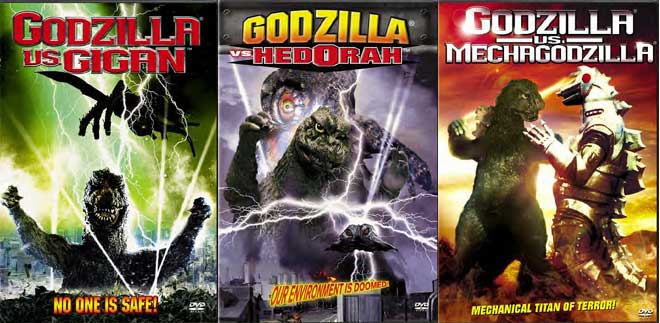

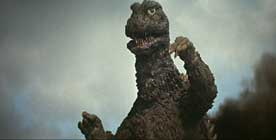
Critics and fans of giant monster movies tend to feel that the Japanese Godzilla series from Toho took a nosedive in the 1970s in terms of quality. The films certainly looked cheaper, often substituting carefully constructed model skyscrapers with barren soil for the monsters to battle on, and the plots aimed at a more juvenile audience, with the big green guy being a mammoth superhero and a friend to all children (much like the flying turtle Gamera). Still, the 1970s Godzilla films can be good old fashioned Saturday afternoon man-in-rubber-monster-suit fun, and Columbia TriStar has unleashed three prime examples of the era, here given their first proper U.S. home video releases, uncut and widescreen!
 GODZILLA
VS. HEDORAH (1971) was originally given a major U.S. release by AIP (on an infamous
double bill with FROGS), under the title GODZILLA VS. THE SMOG MONSTER. Columbia's
DVD is the International version, so the English dubbing is different then it
was in the more charming AIP cut, and the American interpretation of the memorable
song, "Save the Earth," which is sung during the opening credits and
heard several more times throughout, is now only heard in Japanese. Opening up
with a woman singing the aforementioned tune amongst a psychedelic background,
intercut with shots of devastatingly polluted waters, you know you're not in for
the usual Godzilla fare, and this is one of the most unusual ones for certain.
GODZILLA
VS. HEDORAH (1971) was originally given a major U.S. release by AIP (on an infamous
double bill with FROGS), under the title GODZILLA VS. THE SMOG MONSTER. Columbia's
DVD is the International version, so the English dubbing is different then it
was in the more charming AIP cut, and the American interpretation of the memorable
song, "Save the Earth," which is sung during the opening credits and
heard several more times throughout, is now only heard in Japanese. Opening up
with a woman singing the aforementioned tune amongst a psychedelic background,
intercut with shots of devastatingly polluted waters, you know you're not in for
the usual Godzilla fare, and this is one of the most unusual ones for certain.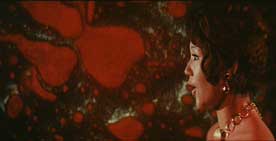
Hedorah, or "The Smog Monster," is a unique, shape-shifting monster. Best identified as a dark blob with red beaming eyes, it not only gets larger during the course of the film, but it emerges from the sea and later flies like a saucer. Hedorah devours pollution, automobiles andfactory smoke, and wipes out people with its acid touch. It also emits heaps of sludge, as well as sulfuric acid-based smog, which poisons plants, rots metal and disintegrates men into fleshless bones. Thought to have evolved from mankind's ecological carelessness, a scientist (badly burned by Hedorah) discovers a way to destroy it, while Godzilla attempts to bring him down in his usual wild wrestling manner.
 GODZILLA
VS. HEDORAH features a more jazz/rock-tinged score, funky animated inserts, a
hipster tripping out in a discotheque and visioning everyone sporting fish heads
and a background of dancing skeletons, teens rebelling by singing and partying
on Mt. Fuji, and other off-the-wall motifs not found in previous entries. Although
there is the common cute kid who adores Godzilla, the film has such mature sights
as a small baby drowning in sludge, a construction worker having his face crisped,
and the very violent fighting between the monsters, with lots of muck and unidentified
Hedorah innards being tossed around. In other words, a surreal monsterpiece!
GODZILLA
VS. HEDORAH features a more jazz/rock-tinged score, funky animated inserts, a
hipster tripping out in a discotheque and visioning everyone sporting fish heads
and a background of dancing skeletons, teens rebelling by singing and partying
on Mt. Fuji, and other off-the-wall motifs not found in previous entries. Although
there is the common cute kid who adores Godzilla, the film has such mature sights
as a small baby drowning in sludge, a construction worker having his face crisped,
and the very violent fighting between the monsters, with lots of muck and unidentified
Hedorah innards being tossed around. In other words, a surreal monsterpiece!
GODZILLA
VS. GIGAN (1972) has a premise in which alien creatures in human form (get this,
they are actually mutated cockroaches!) arrive on Earth and take over an amusement
park  with
a "Monster Island" theme. Hired to work for the aliens-in-human-guise
(as well as orange game show host attire), a young cartoonist stumbles upon their
dastardly plans to destroy the earth and claim it for themselves. He and his pals
(which include a female martial artist and a hippy fascinated with corn and bananas)
sneak into a secret base to stop the annoying invaders. Keeping with the ecological
themes of the previous film, these aliens come from a distant planet ruined by
industrial waste, pollution and decay, and they summon the three-headed dragon
King Ghidorah, and another monster called Gigan (a beaked, clawed creature with
a buzz saw in its stomach), to do their dirty work. They both do battle with "good"
monsters Godzilla and Anguirus.
with
a "Monster Island" theme. Hired to work for the aliens-in-human-guise
(as well as orange game show host attire), a young cartoonist stumbles upon their
dastardly plans to destroy the earth and claim it for themselves. He and his pals
(which include a female martial artist and a hippy fascinated with corn and bananas)
sneak into a secret base to stop the annoying invaders. Keeping with the ecological
themes of the previous film, these aliens come from a distant planet ruined by
industrial waste, pollution and decay, and they summon the three-headed dragon
King Ghidorah, and another monster called Gigan (a beaked, clawed creature with
a buzz saw in its stomach), to do their dirty work. They both do battle with "good"
monsters Godzilla and Anguirus.
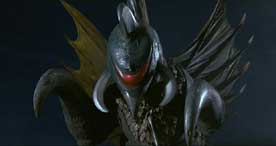 Most
of the monster action here is saved for the ending of the film, but their clash
in Tokyo Bay makes for a pretty awesome spectacle, with Godzilla really taking
a beating before emerging triumphant. Godzilla and his buddy Anguirus apparently
can cross communicate, but in the English dub of the film, they are actually heard
talking to each other in ridiculous grunting voices in some jaw-dropping, hilarious
scenes. The film originally played in U.S. theaters as GODZILLA ON MONSTER ISLAND,
but like many of the 70s Godzilla films, suffered poor distribution and was released
years after it was actually made.
Most
of the monster action here is saved for the ending of the film, but their clash
in Tokyo Bay makes for a pretty awesome spectacle, with Godzilla really taking
a beating before emerging triumphant. Godzilla and his buddy Anguirus apparently
can cross communicate, but in the English dub of the film, they are actually heard
talking to each other in ridiculous grunting voices in some jaw-dropping, hilarious
scenes. The film originally played in U.S. theaters as GODZILLA ON MONSTER ISLAND,
but like many of the 70s Godzilla films, suffered poor distribution and was released
years after it was actually made.
Like
GODZILLA VS. GIGAN, 1974's GODZILLA VS. MECHAGODZILLA also centers on alien 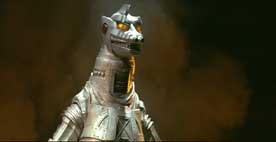 invaders
on earth in human guise. Two new Toho monsters are introduced here, the first
is King Seeser, a shaggy lion/dog thing worshipped by the people of Okinawa who
believe in the ancient prophecy that he and another monster (good old Godzilla
of course) will surface to save the earth. That belief sure comes in handy when
the second new monster Mechagodzilla arrives. Appearing to look just like Godzilla
at first, and violently wounding poor Anguirus, Mechagodzilla later sheds its
scaly green synthetic screen to reveal its super-cyborg self. This metallic menace
is equipped with a number of destructive weapons, including reloading missile
fingers and laser beams that fire from its eyes, making it a challenge for the
authentic Godzilla and the floppy King Seeser.
invaders
on earth in human guise. Two new Toho monsters are introduced here, the first
is King Seeser, a shaggy lion/dog thing worshipped by the people of Okinawa who
believe in the ancient prophecy that he and another monster (good old Godzilla
of course) will surface to save the earth. That belief sure comes in handy when
the second new monster Mechagodzilla arrives. Appearing to look just like Godzilla
at first, and violently wounding poor Anguirus, Mechagodzilla later sheds its
scaly green synthetic screen to reveal its super-cyborg self. This metallic menace
is equipped with a number of destructive weapons, including reloading missile
fingers and laser beams that fire from its eyes, making it a challenge for the
authentic Godzilla and the floppy King Seeser.
 The
subplot involves an ancient statute of King Seeser (which causes the real thing
to wake from its ancient slumber), which the aliens attempt to steal at any cost.
These invaders are led by a smirking guy with a shiny birthmark around his eye,
who also enjoys a good cigar. But in true form, the aliens have greenish gorilla-like
faces, which are revealed at the time of their death. Mostly during the climax,
there's some great, violent monster fighting that highlights the show, with lots
of blood spurting everywhere--but King Seeser is probably the silliest-looking
creature ever to appear in a Godzilla flick. When this was released in the U.S.
in 1977, it was initially called GODZILLA VS. THE BIONIC MONSTER to cash in on
the popularity of "The Six Million Dollar Man" and "The Bionic
Woman," but the producers of the two TV series complained and the title was
changed to GODZILLA VS. THE COSMIC MONSTER. Mechagodzilla would return the following
year in THE TERROR OF MECHAGODZILLA.
The
subplot involves an ancient statute of King Seeser (which causes the real thing
to wake from its ancient slumber), which the aliens attempt to steal at any cost.
These invaders are led by a smirking guy with a shiny birthmark around his eye,
who also enjoys a good cigar. But in true form, the aliens have greenish gorilla-like
faces, which are revealed at the time of their death. Mostly during the climax,
there's some great, violent monster fighting that highlights the show, with lots
of blood spurting everywhere--but King Seeser is probably the silliest-looking
creature ever to appear in a Godzilla flick. When this was released in the U.S.
in 1977, it was initially called GODZILLA VS. THE BIONIC MONSTER to cash in on
the popularity of "The Six Million Dollar Man" and "The Bionic
Woman," but the producers of the two TV series complained and the title was
changed to GODZILLA VS. THE COSMIC MONSTER. Mechagodzilla would return the following
year in THE TERROR OF MECHAGODZILLA.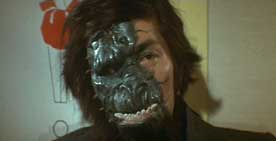
Columbia TriStar's transfers on all three titles are superb, presenting the films in their original 2.35:1 aspect ratios with anamorphic enhancement. The source prints are in pristine condition, and colors and picture detail are excellent. You are given the choice of English (the "international" dubs) or the original Japanese language with solid Dolby Digital 2.0 mono tracks. There are also optional English and French subtitles.
The only extras are trailers on all three titles, which include a Japanese "teaser" for the upcoming GODZILLA: TOKYO S.O.S., GODZILLA THE SERIES - MONSTER WARS, KAENA: THE PROPHECY, STEAMBOY, THE LOST SKELETON OF CADAVRA and the Godzilla "Save the Earth" video game. (George R. Reis)